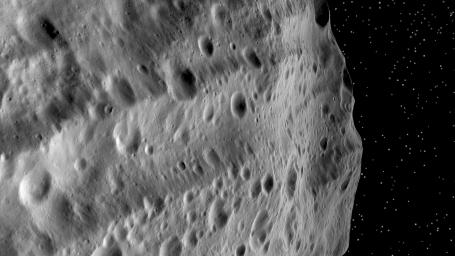Huge Troughs on Vesta
Caption:
This image from NASA's Dawn mission shows huge grooves on the giant asteroid Vesta that were the result of mega impacts at the south pole. As Dawn sent the first close-up images of Vesta back to Earth in July 2011, scientists immediately noticed numerous grooves, as if created by a gigantic plow. This image shows two grooves in the Divalia Fossa system, running parallel to the lower edge of the image.
The majority of these grooves extend along the equator, but a second group -- inclined with respect to the equator -- have been identified in the northern hemisphere. These parallel trenches are usually several hundred miles (kilometers) long, up to 9 miles (15 kilometers) wide and more than a half mile (1 kilometer) deep. They are the result of two large asteroid impacts far in the southern hemisphere, demonstrating that impact events that occurred hundreds of miles (kilometers) apart caused shocks throughout Vesta and altered its surface.
The scene is an artificially generated oblique view of the grooves (or troughs) that run along Vesta's equator. The image was rendered from a global mosaic of Vesta processed from thousands of individual images obtained by the framing camera between January and April 2012. The altitude was approximately 130 miles (210 kilometers) above Vesta's surface. The image resolution is about 70 feet (20 meters) per pixel.
Background Info:
The Dawn mission to Vesta and Ceres is managed by NASA's Jet Propulsion Laboratory, a division of the California Institute of Technology in Pasadena, for NASA's Science Mission Directorate, Washington. UCLA is responsible for overall Dawn mission science. The Dawn framing cameras were developed and built under the leadership of the Max Planck Institute for Solar System Research, Katlenburg-Lindau, Germany, with significant contributions by DLR German Aerospace Center, Institute of Planetary Research, Berlin, and in coordination with the Institute of Computer and Communication Network Engineering, Braunschweig. The framing camera project is funded by the Max Planck Society, DLR and NASA/JPL.
More information about Dawn is online at
http://www.nasa.gov/dawn
and
http://dawn.jpl.nasa.gov
.
Cataloging Keywords:
| Name |
Value |
Additional Values |
| Target |
4 Vesta |
|
| System |
Main Belt |
|
| Target Type |
Asteroid |
|
| Mission |
Dawn |
|
| Instrument Host |
Dawn |
|
| Host Type |
Orbiter |
|
| Instrument |
Framing Camera (FC) |
|
| Detector |
|
|
| Extra Keywords |
Grayscale, Impact |
| Acquisition Date |
|
| Release Date |
2012-05-10 |
| Date in Caption |
|
|
| Image Credit |
NASA/JPL-Caltech/UCLA/MPS/DLR/IDA |
| Source |
photojournal.jpl.nasa.gov/catalog/PIA15673 |
| Identifier |
PIA15673 |

 Planetary Data System
Planetary Data System
